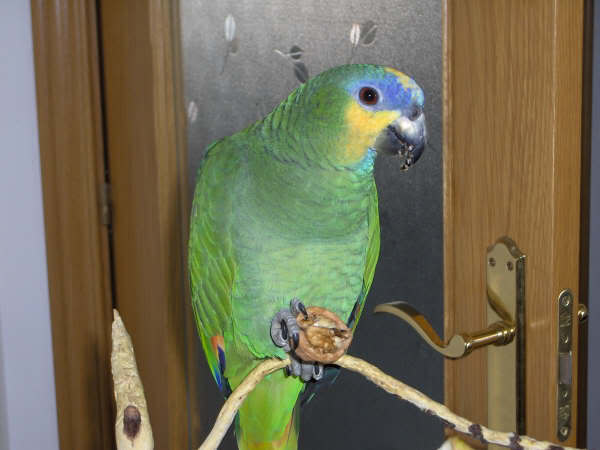
Orange-winged amazon, or Orange-winged parrot, or Loro guaro (Amazona amazonica)
Phylum —chordata
Class — aves
Order — psittaciformes
Family — psittacidae
Genus – amazona
Appearance
The Orange-winged amazon is a mainly green parrot about 33 cm (13 in) long and weighing about 340 g. It has blue and yellow feathers on its head which varies in extent between individuals. The upper mandible is partly horn colored (gray) and partly dark-gray. It has orange feathers in the wings and tail, which can be seen when in flight. The male and female are identical in external appearance.
Habitat
The Orange-winged amazon lives and breeds in tropical regions of South America, from Colombia, Trinidad and Tobago south to Peru, central Brazil and Bolivia.
Behavior
Orange-winged amazons are strictly diurnal and active at early morning and late in the afternoon, often in mixed groups with other Amazona species. A very social species, always found in pair or in large groups. In the daytime, pairs are usually seen flying high between roosts and feeding places. These parrots are noisy, conspicuous, and very gregarious, gathering in large flocks at communal roosts outside of the breeding season. They make loud screams on arrival or when leaving the roost, first gathering in nearby trees before perching for the night to roost, often many hundreds together. The numbers at the roost decline during the breeding season. They often are found high up in trees or in the canopy. When not feeding, these birds, like other parrots, chew bark or wood to keep their beak in good condition, being their main “tool” for eating and for climbing around branches. An Orange-winged amazon utters a wide range of squawks and whistles while it is perched. When flying they make a shrill and high-pitched “kee-wik…kee-wik…kee-wik…kee-wik”, and also a repeated “klee-ak”.
Diet
Orange-winged amazons are herbivores (frugivores and granivores), they eat fruits, seeds, berries, nuts, blossoms, flowers, and leaf buds.
Reproduction
Orange-winged amazons are monogamous and form life lasting pair bonds. The breeding season varies, depending on the location. They are solitary nesters, and their nest is a hole high in a tree. 2 to 5 white eggs are laid and incubation is for about 21 days, just by the female. During the day, the male stays near the nest, roosting at the communal roost at night. Both parents feed the chicks, which fledge when they are about two months old. Young reach reproductive maturity when they are 3 to 4 years old.
In captivity
These birds can live up to 80 years if you provide them with adequate housing, a proper diet, and plenty of affection on a daily basis.
Amazon parrots thrive on social interaction, and they need it to remain healthy and happy. Neglected birds often fall into destructive behavior patterns and depression. Unhappy birds may develop various physical and emotional problems, including feather plucking. Orange-winged amazon owners need to set aside time each day for one-on-one interaction with their bird. This scheduled activity period helps establish and maintain a healthy bond.
Purchase a cage that is at least 2 feet by 3 feet wide and 3 to 5 feet high with a playpen top. Outfit it with plenty of ropes, ladders, and perches so your bird can exercise while enclosed.
While hand-fed amazon parrots typically make loving, affectionate pets, they are also curious explorers that like to chew. Anything in your home can be viewed as a toy and may get chewed if left around. Go along with the bird's instinct to chew and provide plenty of bird-safe toys that can be destroyed.
Once you develop a good understanding of the bird's personality, training is relatively easy. In general, positive reinforcement works best. Reward correct behavior and avoid scolding and punishment.
Amazon parrots are prone to excess weight gain, they must be allowed room to exercise. This bird requires a minimum of 3 to 4 hours outside of its cage each day. Supervised active time helps your bird burn excess calories and stretch its muscles. Training and socializing time is essential to its mental stimulation.
As pets, Orange-winged amazons do best on a high-quality pelleted diet. The pellet food should be supplemented with daily servings of fresh bird-safe fruits and vegetables. A fresh and varied diet will help ensure that your bird maintains top nutrition. Feed approximately 1/3 to 1/2 cup of pelleted food and 1/3 to 1/2 cup of fresh fruits and vegetables daily. A raw and varied diet will help ensure that your bird maintains top nutrition. As with all parrots, avocado, chocolate, rhubarb, coffee beans, and alcohol are toxic to this bird.
 Russian
Russian
 English
English























